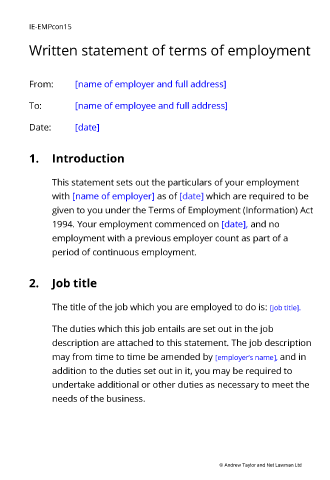Written statement of terms of employment

Document overview


- Length:5 pages (1000 words)
- Available in:
 Microsoft Word DOCX
Microsoft Word DOCX Apple Pages
Apple Pages RTF
RTF

If the document isn’t right for your circumstances for any reason, just tell us and we’ll refund you in full immediately.

We avoid legal terminology unless necessary. Plain English makes our documents easy to understand, easy to edit and more likely to be accepted.

You don’t need legal knowledge to use our documents. We explain what to edit and how in the guidance notes included at the end of the document.

Email us with questions about editing your document. Use our Lawyer Assist service if you’d like our legal team to check your document will do as you intend.

Our documents comply with the latest relevant law. Our lawyers regularly review how new law affects each document in our library.
About this document
In accordance with the Terms of Employment (Information) Act, 1994 as amended under the Employment (Miscellaneous Provisions) Act 2018 and the European Union (Transparent and Predictable Working Conditions) Regulations 2022, all employees must at minimum, be provided with a written statement of the terms of their employment within 5 days of commencement of their employment.
A new employer must provide the following terms within 5 days of the employee starting the job:
- The full names and addresses of the employer and employee;
- The place of work. If there is no fixed or main place of work then a statement stating that there are various places or you are free to set your own place of work or to work at various places
- The date the employment started
- The job title, grade or nature of the work
- The expected duration of the contract
- The rate or method of calculating your pay, and the ‘pay reference period’
- What the employer reasonably expects the normal length of your working day and week to be
- The duration and conditions relating to the probation period (if there is one)
- Any terms or conditions relating to hours of work, including overtime
The remaining terms of employment must then be provided within 1 month of starting work. These terms include:
- Pay intervals (for example, weekly or monthly)
- Paid leave, including your annual leave and public holiday entitlements
- Sick pay
- Pension and pension schemes
- Period of notice to be given by employer or employee
- Details of any collective agreements that may affect your terms of employment
- Any training to be provided by your employer
- For temporary agency contracts, the identity of the person or firm hiring the agency worker
- If the work pattern is entirely or mostly unpredictable, information about the number of guaranteed hours, the hours and days you may be required to work and the minimum notice of a work assignment
- The identity of the recipient agency for social security contributions and any protection relating to your social security arrangements.
This document ensures your compliance if you do not provide the information in a formal contract.
Suitable for use when you have employed a new employee and have not yet completed the employment contract or you do not intend to use a formal contract.
Whether you choose an employment contract or a written statement depends how comprehensive and formal you want your employment agreement to be. This statement can be used either if you are still negotiating the contract after the end of a probationary period of employment, or simply if you do not intend to use an employment contract because you prefer the simplicity of this statement. This statement may be particularly useful if you have just started employing people and want to cut the formality of using contracts.
Application and features of this written statement
- Suitable for use by any employer in any business;
- Suitable for any employee, junior or senior;
- Written in plain English;
- Includes explanatory notes.
Contents of this document
- Names and details of the employer and employee;
- The purpose of the document including the start date of the employment (so the period of continuous employment can be measured);
- Employee’s job title;
- Usual place of work (can be drafted widely so that the employer is able to move the employee if the business requires);
- Remuneration;
- Hours of work;
- Holidays;
- Absence due to sickness;
- Pensions rights;
- Notices to be given of termination of employment;
- Grievance and discipline procedures;
- Authorisation by the employee that they have received understood the document.

All rights reserved
